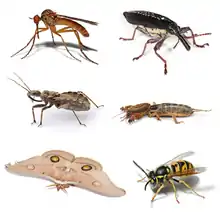Pterygota
The Pterygota (Ancient Greek: πτερυγωτός, romanized: pterugōtós, lit. 'winged') are a subclass of insects that includes all winged insects and the orders that are secondarily wingless (that is, insect groups whose ancestors once had wings but that have lost them as a result of subsequent evolution).[1]
| Pterygota Temporal range: | |
|---|---|
_on_Tribulus_terrestris_W_IMG_1020.jpg.webp) | |
| Giant honey bee Apis dorsata (order Hymenoptera) on Tribulus terrestris | |
| Scientific classification | |
| Domain: | Eukaryota |
| Kingdom: | Animalia |
| Phylum: | Arthropoda |
| Class: | Insecta |
| (unranked): | Dicondylia |
| Subclass: | Pterygota Lang, 1888 |
| Orders | |
For alternative classifications and fossil orders, see text. | |
The pterygotan group comprises 99.9% of all insects.[2] The orders not included are the Archaeognatha (jumping bristletails) and the Zygentoma (silverfishes and firebrats), two primitively wingless insect orders. Also not included is Entognatha, which consist of three orders no longer considered to be insects: Protura, Collembola, and Diplura.
Unlike Archaeognatha and Zygentoma, the pterygotes don't have styli or vesicles on their abdomen (also absent in some zygentomans), and with the exception of the majority of mayflies, are also missing the median terminal filament which is present in the ancestrally wingless insects.[3][4][5]
The oldest known representatives of the group appeared during the mid-Carboniferous, around 328–324 million years ago, and the group subsequently underwent a rapid explosive diversification. Claims that they originated substantially earlier during the Silurian or Devonian based on molecular clock estimates are unlikely based on the fossil record, and are likely analytical artefacts.[6]
Systematics
Traditionally, this group was divided into the infraclasses Paleoptera and Neoptera.[7] The former are nowadays strongly suspected of being paraphyletic, and better treatments (such as dividing or dissolving the group) are presently being discussed. In addition, it is not clear how exactly the neopterans are related among each other. The Exopterygota might be a similar assemblage of rather ancient hemimetabolous insects among the Neoptera like the Palaeoptera are among insects as a whole. The holometabolous Endopterygota seem to be very close relatives, indeed, but nonetheless appear to contain several clades of related orders, the status of which is not agreed upon.
The following scheme uses finer divisions than the one above, which is not well-suited to correctly accommodating the fossil groups.
Infraclass Palaeoptera
(probably paraphyletic)
- Ephemeroptera (mayflies)
- Palaeodictyoptera †(extinct)
- Megasecoptera †(extinct)
- Archodonata †(extinct)
- Diaphanopterodea †(extinct)
- Protodonata or Meganisoptera †(extinct; sometimes included in Odonata)
- Protanisoptera †(extinct; sometimes included in Odonata)
- Triadophlebioptera †(extinct; sometimes included in Odonata)
- Protozygoptera or Archizygoptera †(extinct; sometimes included in Odonata)
- Odonata (dragonflies and damselflies)
Infraclass Neoptera
Superorder Exopterygota
- Caloneurodea †(extinct)
- Titanoptera †(extinct)
- Protorthoptera †(extinct)
- Plecoptera (stoneflies)
- Embioptera (webspinners)
- Zoraptera (angel insects)
- Dermaptera (earwigs)
- Orthoptera (grasshoppers, etc.)
- Phasmatodea (stick insects – tentatively placed here)
- Grylloblattodea (ice-crawlers – tentatively placed here)
- Mantophasmatodea (gladiators – tentatively placed here)
- Proposed superorder Dictyoptera
- Blattodea (cockroaches and termites)
- Mantodea (mantids)
- Alienoptera †(extinct)
- Proposed superorder Paraneoptera
- Psocoptera (booklice, barklice)
- Thysanoptera (thrips)
- Phthiraptera (lice)
- Hemiptera (true bugs)
Superorder Endopterygota
- Hymenoptera (ants, bees, etc.)
- Coleoptera (beetles)
- Strepsiptera (twisted-winged parasites)
- Raphidioptera (snakeflies)
- Megaloptera (alderflies, etc.)
- Neuroptera (net-veined insects)
- Proposed superorder Mecopteroidea/Antliophora
- Mecoptera (scorpionflies, etc.)
- Siphonaptera (fleas)
- Diptera (true flies)
- Protodiptera †(extinct)
- Proposed superorder Amphiesmenoptera
Neoptera orders incertae sedis
- Glosselytrodea †(extinct)
- Miomoptera †(extinct)
References
- Vincent H. Resh; Ring T. Cardé (4 April 2003). Encyclopedia of Insects. Academic Press. p. 64. ISBN 978-0-08-054605-6.
- The Evolution and Genetics of Migration in Insects
- Coxal Setal Organs in Archaeognatha and Zygentoma (Insecta)
- The eversible vesicles of Campodea (Thysanura)
- The Insects: An Outline of Entomology
- Schachat, Sandra R; Goldstein, Paul Z; Desalle, Rob; Bobo, Dean M; Boyce, C Kevin; Payne, Jonathan L; Labandeira, Conrad C (2 February 2023). "Illusion of flight? Absence, evidence and the age of winged insects". Biological Journal of the Linnean Society. 138 (2): 143–168. doi:10.1093/biolinnean/blac137. ISSN 0024-4066.
- Maddison, David (1 January 2002). "Pterygota Winged Insects". Tree of Life.
External links
![]() Media related to Pterygota at Wikimedia Commons
Media related to Pterygota at Wikimedia Commons
